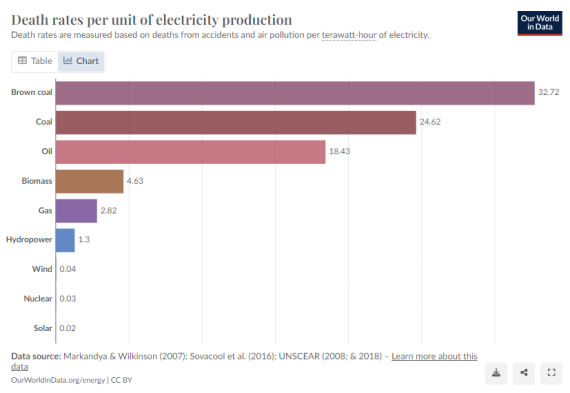
What The Science Says:
Turbine collapse or breakage are extremely rare, utilising safety mechanisms to survive extreme weather conditions, and the mortality rate from wind energy pales in comparison to the risks associated with fossil fuels.
Climate Myth: Wind turbines are error prone and a threat to human health and safety
"There are many health hazards associated with living near turbines as a result of . . . broken flying blades." (Save Piatt County)
Turbine collapse or breakage are extremely rare, and utility-scale wind turbines are fitted with safety mechanisms to survive extreme weather conditions, such as hurricanes1. Turbine blade breakage does not pose a significant threat to humans (McGugan et al. 2015). The Department of Energy has noted that, although the risk of turbine blades becoming detached during operation “was a concern in the early years of the wind industry,” such failures “are virtually impossible with modern turbines due to improved engineering and the use of hazard sensors.”2 Turning to all turbine blade failures, rather than just turbine blade detachment, a 2015 study found that wind turbine blades fail at a rate of approximately 0.54% per year globally3. The Department of Energy has further reported that “catastrophic wind turbine failures . . . are considered rare events with fewer than 40 incidents identified in the modern turbine fleet of more than 40,000 turbines installed in the United States as of 2014.”4
When looking at deaths per terawatt-hour of energy produced, the mortality rate from wind energy pales in comparison to the risks associated with fossil fuels. Brown coal causes 32.72 human deaths per terawatt-hour, while black coal causes 24.6 human deaths, oil causes 18.4 human deaths, natural gas causes 2.8 human deaths, and wind energy causes only 0.04 human deaths5.
Figure 1: Death rates per unit of electricity production. Source: Hannah Ritchie, Our World in Data.
Footnotes:
[1] How do wind turbines survive severe storms?, Office of Energy Efficiency and Renewable Energy, U.S. Department of Energy, (archived Feb. 25, 2025)
[2] Wind Energy Projects and Safety, Dep’t of Energy (archived Feb. 25, 2025)
[3] GCube Insurance Services, Inc. GCube report: breaking blades: global trends in wind turbine downtime events (2015), summarized in Chen & Eder (2020), A Critical Review of Damage and Failure of Composite Wind Turbines Blade Structures, IOP Conference Series: Materials Sci. and Engineering (2020)
[4] Wind Vision: A New Era for Wind Power in the United States, U.S. Department of Energy, 105 (2015) (archived Feb. 25, 2025)
[5] Hannah Ritchie, What are the safest and cleanest sources of energy?. To the extent that wind-related fatalities tend to occur disproportionately during the construction phase, this analysis may overstate the fatalities per terawatt-hour of wind, which would be expected to decline over time. See Benjamin K. Sovacool et al. (2016), Balancing safety with sustainability: assessing the risk of accidents for modern low-carbon energy systems, 112 Journal of Cleaner Production 3952, 3960, Jan. 20, 2016, (showing in Table 5 that most wind-related deaths occurred during construction)
Note: rebuttal updated on March 22, 2025 to reflect changes in Sabin's original publication. Several links changed to use archived versions.
This rebuttal is based on the report "Rebutting 33 False Claims About Solar, Wind, and Electric Vehicles" written by Matthew Eisenson, Jacob Elkin, Andy Fitch, Matthew Ard, Kaya Sittinger & Samuel Lavine and published by the Sabin Center for Climate Change Law at Columbia Law School in 2024. Skeptical Science sincerely appreciates Sabin Center's generosity in collaborating with us to make this information available as widely as possible.
 |
The Skeptical Science website by Skeptical Science is licensed under a Creative Commons Attribution 3.0 Unported License. |